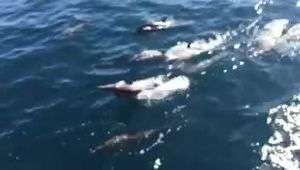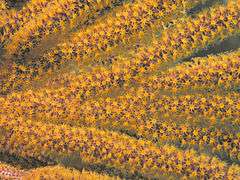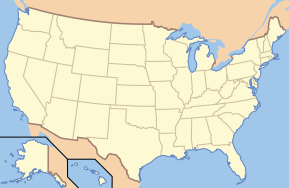Channel Islands National Park
| Channel Islands National Park | |
|---|---|
|
IUCN category II (national park) | |
|
A beach in Channel Islands National Park | |
 Location of Channel Islands National Park | |
| Location | Santa Barbara County & Ventura County, California, United States |
| Nearest city | Santa Barbara |
| Coordinates | 34°0′30″N 119°25′0″W / 34.00833°N 119.41667°WCoordinates: 34°0′30″N 119°25′0″W / 34.00833°N 119.41667°W |
| Area | 249,561 acres (100,994 ha)[1] |
| Established | March 5, 1980[2] |
| Visitors | 324,816 (in 2015)[3] |
| Governing body | National Park Service |
| Website | Channel Islands National Park |

Channel Islands National Park is a United States national park that consists of five of the eight Channel Islands off the coast of the U.S. state of California, in the Pacific Ocean. Although the islands are close to the shore of densely populated Southern California, their isolation has left them relatively undeveloped. The park covers 249,561 acres (100,994 ha) of which 79,019 acres (31,978 ha) are owned by the federal government.[1] The Nature Conservancy owns and manages 76% of Santa Cruz Island, the largest island in the park.[4]
Channel Islands National Park is home to a wide variety of significant natural and cultural resources. It was designated a U.S. National Monument on April 26, 1938, and a National Biosphere Reserve in 1976. It was promoted to a National Park on March 5, 1980.[5][6] Channel Islands National Marine Sanctuary encompasses the waters six nautical miles around Channel Islands National Park.
History
The Channel Islands were originally discovered in 1542 by the explorer Juan Rodríguez Cabrillo.[7][8] In 1938 the Santa Barbara and Anacapa islands were designated a national monument. San Miguel, Santa Rosa and Santa Cruz islands were combined with the monument in 1980 to form modern-day Channel Islands National Park.[7]
Oil spill
On January 28, 1969 an oil rig belonging to Union Oil experienced a blow-out 6 miles (9.7 km) off the coast of California.[9] The resulting spill was, at the time, the largest oil spill to occur in United States territorial waters. Crews took approximately 11 days to seal the rupture using a cement plug, during which approximately 200,000 US gallons (760,000 litres; 170,000 imperial gallons) of crude oil spilled into the Pacific Ocean, creating an oil slick with an area of about 800 square miles (2,100 km2).[7][10] Following the spill, tides carried the oil onto the beaches of the Anacapa, San Miguel, Santa Rosa and Santa Cruz islands.[10]
This spill had a large impact on native wildlife of the Channel Islands. Much of the islands' seabird population was affected, with over an estimated 3,600 avians killed. Meanwhile, seals, dolphins and other sea life died and washed ashore on both the islands and the mainland.[10][11]
This spill is the third largest oil spill in the United States, only surpassed by the Deepwater Horizon and the Exxon Valdez oil spills.[9] It resulted in a 34,000 acres (14,000 ha) expansion of the Department of the Interior buffer zone in the channel and contributed to the formation of the Environmental Protection Agency.[12]
Geography
The islands within the park extend along the Southern California coast from Point Conception near Santa Barbara to San Pedro, a neighborhood of Los Angeles. Park headquarters and the Robert J. Lagomarsino Visitor Center are located in the city of Ventura.
The park consists of 249,354 acres (100,910 ha), half of which are under the ocean, and includes the islands of:
- San Miguel 9,325 acres (3,774 ha)
- Santa Rosa 52,794 acres (21,365 ha)
- Anacapa 699 acres (283 ha)
- Santa Barbara 639 acres (259 ha)
- Santa Cruz 60,645 acres (24,542 ha) 76% owned by the Nature Conservancy, 24% by the National Park Service
Flora and fauna

More than 2,000 species of plants and animals can be found within the park.[13] However, only three mammals are endemic to the islands, one of which is the deer mouse (Peromyscus maniculatus) which is known to carry the sin nombre hantavirus. The spotted skunk and Channel Islands fox also are endemic. The island fence lizard[14] is also endemic to the Channel Islands.[15] Other animals in the park include island scrub jay, harbor seal, California sea lion, island fox, spotted skunk, island night lizard, barn owl, American kestrel, horned lark and meadowlark and California brown pelican. One hundred and forty-five of these species are unique to the islands and found nowhere else in the world. Marine life ranges from microscopic plankton to the endangered blue whale, the largest animal on earth. Archeological and cultural resources span a period of more than 10,000 years.
Tourism
Annual visitation to the park's mainland visitor center is around 300,000. The visitor center is located in the Ventura Harbor Village. The visitor center contains several exhibits which provides information regarding all five islands, native vegetation, marine life and cultural history. Also, visitors can enjoy a short film, free of charge, that provides an overview of all five islands. The visitor center is open every day, except Thanksgiving and Christmas, from 8:30AM-5:00PM.[16] Visitation to the islands and waters is low, with about 30,000 visitors traveling to the islands, and another 60,000 who go only into park waters. Although most visitation occurs in the summer, migrating gray whales and spectacular wildflower displays attract visitors in the winter and spring. Autumn is an excellent time to travel to the park, as well as for diving, as the days are usually sunny, with minimal winds and clear ocean water. Camping is a popular activity on Santa Cruz Island, with visitors arriving at Prisoners Harbor [17] on the north shore and staying in the valley beyond. A new island visitor center opened at Scorpion Ranch on Santa Cruz Island on April 6, 2009.[18]
Recreation
Channel Islands National Park offers a wide variety of recreation activities, kayaking through the sea caves being one of the most popular. Backpacking, camping, day hiking, scuba diving, and spearfishing are among the activities available to visitors. Channel Islands National Park is renowned for its large number of complex, beautiful sea caves. Based on ocean conditions and ferry availability, Scorpion Anchorage on Santa Cruz Island is the most visited area in the park for day and camping visitors. It is recommended that inexperienced visitors use caution when visiting the national park due to changing ocean conditions in this unique ecosystem. The National Park Service authorizes a small number of guide and outfitter services.[19]
Gallery
 Channel Islands National Park
Channel Islands National Park Diver and juvenile sea lions, Anacapa Island
Diver and juvenile sea lions, Anacapa Island Sea fan, Anacapa Island
Sea fan, Anacapa Island San Miguel Island
San Miguel Island Santa Cruz Island in the spring.
Santa Cruz Island in the spring.
Vessels
The CINP unit operates several vessels in the waters of the park, including the following:
- Surf Ranger LCM-8 landing craft, 74 ft.[20]
- research diving boat Pacific Ranger 56 ft.[21]
- Sea Ranger II 58 ft.[22]
- Ocean Ranger 100 ft.[23]
- Sea Ranger 41 ft (retired).[24]
See also
- Channel Islands of California
- California coastal sage and chaparral ecoregion
- List of California Channel Islands wildlife
- When the Killing's Done – a novel by T.C.Boyle
References
- 1 2 "Listing of acreage as of December 31, 2012". Land Resource Division, National Park Service. Retrieved 2013-09-22.
- ↑ Carlson, Cheri (September 2, 2016). "Bringing Channel Islands National Park to the people". Ventura County Star. Retrieved 5 September 2016.
- ↑ "NPS Annual Recreation Visits Report". National Park Service. Retrieved 2015-06-16.
- ↑ "Santa Cruz Island". National Park Service. Retrieved 2011-07-13.
- ↑ "Channel Islands National Park". The National Parks: Index 2009–2011. National Park Service. Retrieved 2011-07-13.
- ↑ 96th U.S. Congress. "An Act To establish the Channel Islands National Park, and for other purposes" (pdf). United States Government Printing Office. (Pub.L. 96–199, 94 Stat. 67, enacted March 5, 1980)
- 1 2 3 Channel Islands. (2016). In Encyclopædia Britannica
- ↑ Channel Islands National Park. (2016). Funk & Wagnalls New World Encyclopedia, 1p. 1.
- 1 2 "Brief Oil and Gas History of Santa Barbara County". Energy Division, Santa Barbara County. Archived from the original on April 18, 2011. Retrieved December 12, 2008.
- 1 2 3 "1969 Oil Spill – Summary Articles and Images". www.geog.ucsb.edu. Retrieved 2016-10-14.
- ↑ "The 1969 Santa Barbara oil spill that changed oil and gas exploration forever". Los Angeles Times. ISSN 0458-3035. Retrieved 2016-10-14.
- ↑ The 1969 Santa Barbara Oil Spill. (cover story). (2010). Parks & Recreation, 45(11), 42.
- ↑ Carlson, Cheri (March 6, 2015). "Lookout tower gives glimpse underwater as Channel Islands park turns 35". Ventura County Star. (subscription required (help)).
- ↑ William, Flaxington (2005). "Photograph of the Island Fence Lizard". Calphotos. Retrieved 2013-09-22.
- ↑ Hogan, C. Michael (2008). Stromberg, Nicklas, ed. "Western fence lizard (Sceloporus occidentalis)". Globaltwitcher. Retrieved 2013-09-22.
- ↑ , Channel Islands National Park Basic Information
- ↑ "Boating – Channel Islands National Park". National Park Service. Retrieved 2013-09-22.
- ↑ "Public to Enjoy New Visitor Center and Exhibits on Santa Cruz Island". National Park Service. 2009. Retrieved 2014-04-13.
- ↑ "Visitor Services List – Channel Islands National Park". National Park Service. Retrieved 2014-04-13.
- ↑ "Environmental Leadership In The National Parks" (PDF). National Park Service. Retrieved 2013-09-22.
- ↑ "Channel Islands National Park Business Plan" (PDF). National Park Service. 2004. Retrieved 2013-09-22.
- ↑ "20100604 - Channel Islands National Park - Anacapa Island - California (Travel)-A258973.JPG". Jason O. Watson Photography, LLC. Retrieved 7 March 2015.
- ↑ "Archived copy". Archived from the original on 2013-09-27. Retrieved 2013-06-01.
- ↑ Press release (October 17, 2001). "Channel Islands National Park Christens New Boat". Retrieved 7 March 2015.
External links
| Wikimedia Commons has media related to Channel Islands National Park. |
| Wikivoyage has a travel guide for Channel Islands National Park. |
- Official site: Channel Islands National Park
- Channel Islands National Park Visitor's Guide
- NPS Public domain pictures of park


